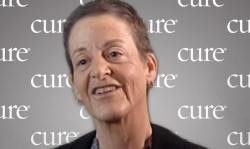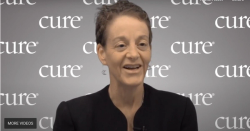- About Us
- Advertise / Support
- Editorial Board
- Contact Us
- CancerNetwork.com
- TargetedOnc.com
- OncLive.com
- OncNursingNews.com
- Terms & Conditions
- Privacy
- Do Not Sell My Information
- Washington My Health My Data
© 2025 MJH Life Sciences™ and CURE - Oncology & Cancer News for Patients & Caregivers. All rights reserved.
The 'Promise' of Precision Medicine: Making Incurable Cancers Into Chronic Diseases

Antonia DePace, Editor for CURE®, has covered medical news for MJH Life Sciences, CURE®’s parent company, since 2021. She has written for EatingWell, Natural Awakenings Greater Boston, The Boston Globe and a variety of other lifestyle publications. She attended Emerson College, where she studied journalism and publishing. Antonia enjoys traveling, cooking, yoga and all things health and wellness. Follow her on Instagram @antonialdepace or email her at adepace@curetoday.com
One oncologist highlighted the knowledge base of the immunotherapy and targeted therapy and how they interact with cancer cells.
Targeted and immune therapies allow health care teams to tailor treatment to an individual or specific situation by exploiting unique vulnerabilities in cancer, an expert said.
Dr. Kalyan Banda, an assistant professor of medical oncology at the University of Washington in Seattle, spoke on the topic of precision medicine — specifically targeted therapies and immunotherapies, highlighting how the therapies work, during the Joining Forces Against Hereditary Cancer Conference.
“The great hope today is that we can take all incurable cancers and make them chronic diseases that are mere nuisances. Take it from something deadly to something that will not affect the quality or quantity of an individual's life. The other promise is that we take all early-stage cancers and treat them so effectively, that they will never come back again. This is the promise of precision medicine. It still has a way to go to achieve that promise,” Banda said during the presentation.
Understanding Targeted Therapies
The first step to understanding immunotherapy and targeted therapies, according to Banda, is understanding what cancer is. “The answer should be obvious enough, but the real question I'm asking is what is unique about a cancer cell compared to a normal cell,” he explained.
Banda described cancer as an “outlaw organ,” one that refuses to confine to its niche. It can also lead to mutations, which can shut down genes that normally regulate cells in the case that there’s damage to the others. “If there's a mutation in B53, which can be inherited … or acquired in the cancer itself, this checkpoint, this guardian, is suddenly vanished, and the cancer can now escape the normal mechanism and start multiplying,” he said. This allows the cancer cells to escape death, grow their own blood vessels, ensure their own nutrition and keep growing. When this occurs, most cancer cells also develop mutations like BRCA.
“Now that we know what's unique about these cancers, we've also provided an opportunity to target these unique abnormalities, and that, in the sense, is what targeted therapy is. There are things that exploit these unique biological abnormalities in cancer and target them specifically,” he added. In comparison to treatments like chemotherapy, which kills both normal and abnormal cells, targeted therapy uses specific abnormalities in cancer cells — like mutations — to attack them in specific ways. In other words, targeted therapies are not restricted to specific mutations or syndromes. Some examples of targeted therapies include PARP inhibitors, PIK3CA inhibitors and FLT3 inhibitors.
Blocking Cancer’s Handshake
On the other hand, immunotherapies alter the immune system to kill the cancer rather than targeting the specific biological abnormality of the cell.
“All of us have an immune system that develops usually when we were fetuses, and what the first thing it learns is what is self and what's not self. What defines this individual, what (does not) define this individual. And cancer is a part of us. It just comes from our own normal cells. It has several abnormalities. What it can do in a sense is then keep telling our immune system (that they are) normal,” Banda explained.
How cancer cells do this is by tricking the immune system into thinking that they are not a threat. Banda described it as a “handshake.” He said, “Our immune system indulges in handshakes all day. That's how we as human beings tell another human being that we're safe. I'm your friend. I'm not your enemy. That's the first indication that this individual is not a threat. That's also what the immune system does; it constantly tries to do handshakes and smile with all the cells’ encounters. And cancer's figured out a way where it does this handshake it smiles and say, ‘I am not a threat, I am part of you.’ There are these particular proteins that meet together to do this handshake.”
This is where immunotherapy comes in. The novel treatment can block the “handshakes” so that the immune system still recognizes the cancer cells as abnormal.
This can be done in a variety of ways thanks to a number of Food and Drug Administration (FDA)-approved immunotherapies like monoclonal antibodies or immune system proteins. Examples of approved monoclonal antibodies include Keytruda (pembrolizumab), Opdivo (nivolumab) and Yervoy (ipilimumab).
Of note, more than a dozen cancer types are eligible for FDA-approved immunotherapies, according to the Cancer Research Institute. Some of those include melanoma, lung, bladder, kidney, lymphoma, leukemia and prostate cancers.
Banda added, that by using these therapies, “You've taken the brakes of your immune system. Your immune system is now able to recognize the cancer as abnormal and start chomping at it. And that's how immunotherapies work. It really works best if your cancers look quite abnormal, meaning the cancer looks quite different from a normal cell, and that is when the cancer has several mutations and is constantly changing. Those kinds of cancers are usually melanoma or lung cancer or bladder cancers. For some reason, these cancers just have a lot of mutations. Otherwise, immunotherapies have to be combined with other chemos in some situations.”
When it comes to deciphering which therapy or treatment plan that is best suited for a patient’s diagnosis, Banda recommends speaking to their oncologist and considering clinical trials. “All of these therapies today have come from clinical trials. And those trials have direct benefit to an individual, they also have (a) larger benefit to society.”
For more news on cancer updates, research and education, don’t forget to subscribe to CURE®’s newsletters here.
Related Content:




